Drone racing is a brand-new type of sport that has gotten quite the popularity with the rise of the drone market. This comes as no surprise since drone racing was always bound to happen. As soon as the first drones hit the market, there was already a ton of people looking to increase their power in order to make them suitable for high speed racing. Nowadays, drone racing is a real sport with its own world championship that took place in Hawaii in 2016. Drone pilots from all over the world competed in this prestigious event and battled for a total prize pool of whopping $100,000. If you are an experienced drone racer or you are just looking for a new hobby, we are proud to present you with a list of the best racing drones currently available on the market.
SLIDE DOWN TO :
-
Ready to Fly Racing drones vs DIY Kits
-
Best RTF FPV Racing drones
-
Best racing drone kits
-
Best FPV Goggles for racing drones
-
Most important racing drone characteristics
-
racing drone components explained
Racing vs aerial photography drones
You will be surprised to find out that drones for racing are much different than the standard ones. Racing drones are much lighter and smaller allowing them to be more agile in midair. On the other hand, standard drones such as DJI Phantom 4 or Autel Robotics X-Star Premium are big bulky devices that have a focus on steady flight rather than pure speed and agility.
That’s why racing drones are made from durable but extremely lightweight material, most frequently carbon fiber. Additionally, they are also paired up with enthusiast-grade transmitters and receivers which annihilate any latency and input lag that might occur. Most of them possess the so-called mushroom antennas which aid in providing lag-free controls and silk smooth live feed.
To summarize, here’s a short list of differences between racing and aerial photography drones:
| Racing | Aerial Photography |
| Focus on speed and maneuverability | Focus on stability, flight aid and image quality |
| Lightweight | Heavy, even more so when carrying a camera |
| The majority is made out of carbon fiber | Made with a wide variety of materials |
| Most of them lack autonomous flight modes | Packed with smart features and flight modes |
RTF vs Kits
Before we get into the lists down below, first I must explain main differences between ready to fly (RTF) drones and racing kits. Here we go:
RTF (Ready to fly)
As the name suggests, these drones are ready to fly straight out of the box meaning there is no assembly required. Usually, they come with everything you need except perhaps batteries for the controller. Main advantage of these drones is the ability to race them straight away with no lost time on assembly and all that. The biggest downside is upgradeability issues, especially for people who never disassembled a drone before. Another thing you should keep an eye out for is FPV. If your RFT drone does not have a FPV kit included, you should go ahead and purchase a standalone one. But, beware – you must match TX frequency and bands otherwise your FPV setup won’t work.
Racing kits
On the other hand, racing kits are completely different pair of shoes. They don’t come assembled… at all. If you purchase a racing kit you will be greeted with a box filled with miniature parts that you are supposed to clamp together all by yourself (or with a help of your friend, sibling, etc). I’m not trying to scare you but – things can get a lot of tricky, especially if you never did anything like this before. Tampering around with electronics, precise soldering, wiring and all that good stuff require a lot of patience and steady hands. Realistically, building your own racing drone can take anywhere from several hours to several days, depending on your expertise. However, nothing can take away that feeling of pride after you’ve placed everything and your drone works like a charm!
Read more : Best camera drones / Follow me drones / Most expensive drones / Surveillance drones
11 Best Ready to fly racing drones
Under $200
Blade Mach 25

First thing you will notice about Blade Mach 25 is its design – it’s safe to say it looks nothing like other racing drones. That’s because it sports a flashy polycarbonate shell with gorgeous graphics design. Underneath the body, there are highly modified parts such as all-in-one ESC+PDB system, Spektrum A3174 receiver as well as E-filte 3S 1350mAh 30C LiPo battery. Since we’re talking about a small 250mm model which is quite lightweight, there’s no doubt this battery can effectively support it for roughly 6 minutes (Here’s list of 10 drones with longest battery life).
Continuing, I’d like to mention a couple of words on how Blade Mach 25 generally performs. It sports a solid CCD FPV camera which means you won’t have any issues with latency. Additionally, Blade Mach 25 can boast with bright LED lights too. On the downside, we are talking about a BNF model (bind and fly) which means you don’t get the controller/transmitter. Keep in mind that its receiver is only compatible with Spektrum radios.
Show me the best price for : United States
Odyssey Starfall X – FPV Racing drone
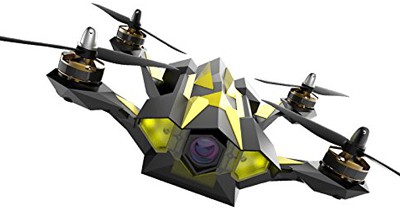
Good news is that FPV on this FPV racing drone works without any lag up to 300 meters. Likewise, 500 meters is its maximum drone operating range which is great too. Combine that with roughly 8 to 10 minutes of flight time and you got yourself a decent racing drone hybrid. It runs on a 1300 mAh battery. Good news – you get an extra one inside the package which is always a good plus. Powerful brushless motors are in charge for Odyssey Starfall X to reach amazing speeds up to 55 mph. With that in mind, it is safe to say this drone can win races!
Lastly, I’d just like to add that Starfall X by Odyssey supports FPV goggles as well through 5.8Ghz connection. Fat Sharks are supported and the built in 1080p camera will do wonders with them. All in all, if you are interested in drone racing and looking for an easy-to-fly hybrid, Odyssey Starfall X seems to be the perfect solution.
Show me the best price for : United States
Walkera Rodeo 110
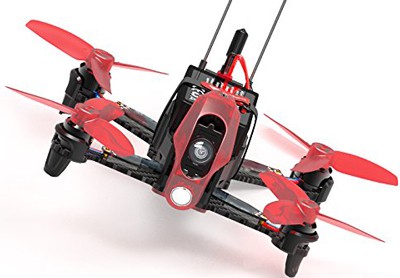
Starting off with specialties, it is nice to see a fully-fledged 600TVL wide-angle camera on such a small drone. Paired together with 200MW/600MW transmission, latency is clearly not an issue with Walkera Rodeo 110. Considering this is a miniature 110mm drone, it is not that surprising to see a lowly 850mAh LiPo battery. Even though it doesn’t have the best power capacity, it still performs well and can endure up to 6 minutes of active flight.
When it comes to other parts, Walkera Rodeo 110 features F3 flight controller and carbon fiber frame. Even though radio only supports PPM and SBUS, you can install other radios such as Futaba. Lastly, I’d like to mention that it is insanely steady when flying and beginner-friendly. It even incorporates flight stabilization which is great help for first time pilots. So, all things considered, if you’re a beginner and want something that can hone your skills and give you a nice learning curve, it doesn’t get much better than Walkera Rodeo 110.
Show me the best price for : United States
$200 to $400
Eachine Wizard X220
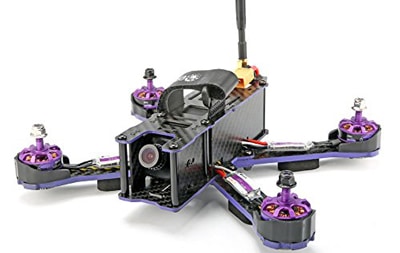
Eachine Wizard X220 runs on 2205 2300KV motors paired together with powerful 20A ESCs. Flight controller is F3 6DOF which sports both Mode 1 and Mode 2 controls. Continuing, Eachine Wizard X220 comes with a high quality 700TVL CCD camera and a dedicated 5.8Ghz 48CH 200mw transmitter. Default propellers are King Kong purple ones, but you are more than welcome to replace them.
Battery is here as well. More precisely, 3S 11.1V 1500mAh 25C XT60 LiPo battery. Going for an extra one would be a good idea too. B3 charger as well as other accessories such as antenna, battery strap and wrenches also come with the package. Even though this is a more advanced RTF drone, it is still beginner friendly. Don’t get me wrong. It does not have stabilization, one key return, altitude hold and all that beginner stuff, but it’s still highly responsive and lessens the general learning curve.
Show me the best price for : United States
Arris X-Speed 250B V2
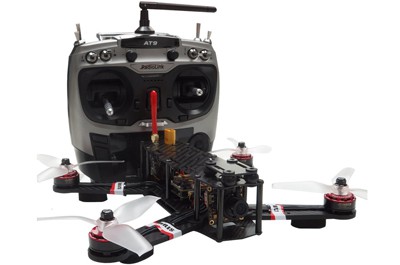
Needless to say, this is an RTF model that comes with everything you need to start practicing. Of course, for those who want to take things to the next level there’s always option to buy FPV goggles which will kick things up in terms of immersion. X-Speed 250B V2 is based on Raptor 390 Tower and features 30A ESCs together with F3 flight controller. PD board is here too, as well as Radiolink AT9 transmitter. Additionally, it also comes with a 4S 1500mAh LiPo battery that makes sure it can fly around without any power-related issues.
700TVL 2.8mm camera is here as well. Best thing about it – tilt is fully adjustable which gives you plenty of room to find the perfect settings. Transmitter, receiver (both RC and FPV) are all present. Technically, the only things separating this from a 100% full package are FPV goggles and battery charger. Other than that, Arris X-Speed 250B V2 is as complete as they come!
Show me the best price for : United States
Walkera F210
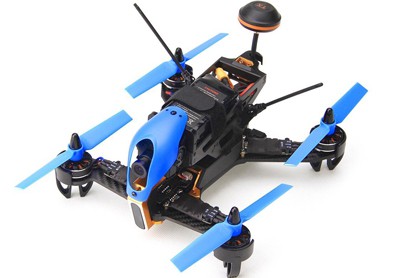
Packed with a serious hardware, why don’t we start off with F210’s controller. We are talking about the ever so popular Devo 7 which features a small LCD Display (Drones with display on remote) as well as lag-free controls that many professionals swear by.Moving to the actual drone, F210 incorporates a modular design which is easy to maintain and assemble if something goes wrong. Crashes are frequent, we all know that… but what’s important is that Walkera F210 can survive bad ones without even breaking a sweat.
This is due to a well-manufactured frame and technically all other parts of the build. The biggest downside to this one is that, if you manage to shut down Devo 7 controller while your drone is flying, you will never see your drone again since it’s going full throttle to the direction it was heading. My friend had that happen to him and… obviously… he was enraged…
Show me the best price for : United States
Rise Vusion 250 Extreme
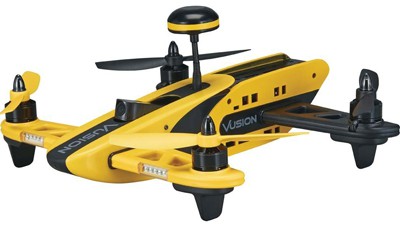
First off, it needs to be said that this is a completely assembled drone that comes with EVERYTHING you need for FPV racing… including FPV goggles! With that out of our way, let’s check out a bit more technical side to Rise Vusion 250 Extreme. Kicking things off with the motors, Rise Vusion 250 Extreme runs on 2280kv brushless ones. Paired up with 11.1V 1500mAh 25C LiPo battery as well as its dedicated charger. Controller has decent build quality but unfortunately does not have a built-in display. That’s why you will have to use your smartphone. Same goes for the provided FPV goggles too.
Lastly, I’d like to say a couple of words about the way this thing flies. To be honest, I was a bit skeptical at first since I don’t trust these all-in-one racing drones. But, I was pleasantly surprised by Vusion’s performance. It glides smoothly and is highly responsive. One thing I didn’t like is the sensitivity but that can be taken care off in a matter of minutes.
Show me the best price for : United States
Eachine Racer 250
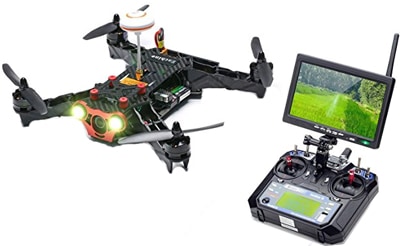
Of course, Eachine Racer 250 sports a FPV ready camera – the powerful 1000TVL which is superior over its competition. Moreover, it runs on the well-known 2204 2300KV brushless motors combined with CC3D flight controller and 1500mAh battery which allows up to 15 minutes of flight time. Among the features, Eachine’s Racer 250 has snowflakes screen, OSD information such as flight time, available channels, battery voltage and more.
And finally, to top it all off, this little fella has 3W white LED lights for those high-speed night races that are gaining so much popularity nowadays. With that being said, I would just like to add that I’ve been personally using Eachine Racer 250 for almost a year now (although not that frequently) and trust me – when it comes to value for money ratio there aren’t many better models than this one. So, if that’s what you’re looking for, then don’t hesitate to pick out Eachine Racer 250.
Show me the best price for : United States
Arris C250 V2
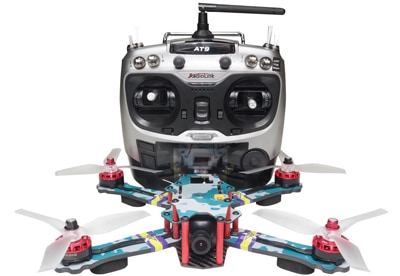
It’s an upgraded version with a more powerful motors and propellers. We are talking about X2205 2300KV brushless motors and 5042 propellers. They have a much bigger windward area and are able to effectively balance root making them 10% more efficient than regular propellers. More efficiency is always a good thing, don’t you agree?
In addition to that, the C250 V2 sports the 4in1 30A tower that has no issues with messy wiring and circuitry, allowing you to have a seamless racing experience whenever you’d like. Inside the package, you will also get the popular Radiolink AT9 controller with a small display for live video and OSD monitoring. It is also important to add that it uses the same exact camera as the previous drone on our list – the 1000TVL. You don’t have to worry about missing any action because this racing camera is as good as it gets.
Show me the best price for : United States
Over $400
ImmersionRC Vortex
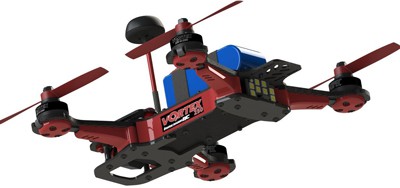
We are talking about a relatively big and bulky drone that fits within 250mm racing category. First thing you should know about it before purchasing is the fact that it comes without several key components. In other words, I you want to get this thing in the air you will have to buy a battery, radio and receiver. An additional step is a FPV camera too which, unfortunately, also does not come with the package.
The best value for money would be to purchase Spektrum DX6 remote controller and pair it up with a PPM Spektrum receiver for binding with transmitter. While this all might seem like a lot of work, in reality you’ll be done with it in less than an hour… that is if you have all parts at hand. Finally, once you’re all done and get ImmersionRC Vortex in the air, you’ll be amazed by its elegance. It really lessens learning curve and provides enjoyable FPV experience for both beginners and more experienced pilots alike.
Show me the best price for : United States
USA Toyz DYS XDR220
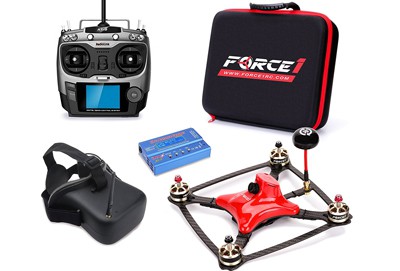
On each side, there’s a powerful SE2205 2300kv brushless motor that’s helped by a 1300mAh 11.1V 45C 3S1P battery. Sure, you don’t have to choose this one. You can up the battery to a 4S 1500mAh and expect great performance too. In terms of controllability, DYS XDR220 comes with AT9 transmitter and a mushroom antenna that further increases its operating range. More precisely, this little guy can reach approximately 1 kilometer away from its controller.
At such a long range, there’s no doubt you’ll see this little fella. Luckily, folks over at USA Toyz thought about that too. So, they’ve provided with not just one but two methods of enjoying FPV. First being a small LCD display on AT9 controller and second being a dedicated pair of FPV goggles (don’t require a smartphone to work) for the ultimate immersion. If that’s not enough to sell you this one… then I don’t know what else is there to add.
Show me the best price for : United States
3 Best drone racing kits :
Walkera Runner 250
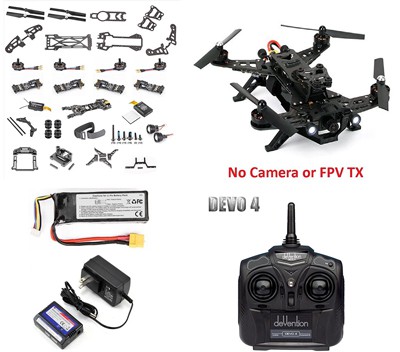
Most of you know that Walkera is well known for its ability to produce high speed racing drones… and their 250mm version is a perfect example of that. If you did not know by now, the numbers after the names of racing drones represent the distance between 2 of its furthest motors in millimeters. With that being said, Walkera Runner 250 has roughly 250mm (offsets of 10mm give or take are allowed) in between two of its furthest motors. It’s that simple. Now you would think that distance has no effect on the speed of a drone, but that’s not the case. It greatly affects the drone’s performance. That’s the reason of all those different racing classes in drone races (f.e. 120, 250, 350 and so on).
For this model, you can expect roughly 40mph with the default parts that come inside the assembly kit. That’s pretty fast and when combined with proper racing PFV goggles it makes one hell of a racing drone. You can easily set that up since this drone doesn’t come with a camera nor a transmitter which will make pairing that much easier. All in all, if you are looking for an excellent barebone racing drone kit but you do not want to spend awfully lot of money, then this little fella is all you need!
Show me the best price for : United States
LHI 250
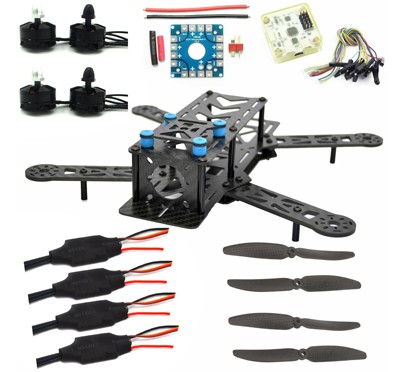
Moving forward, main firepower is coming from 4 MT2204 2300kv motors. Obviously, they’re brushless and provide decent torque. When it comes to additional parts, LHI racing kit is even more basic than that of Walkera. In addition to motors and their ESCs, you’ll also get a total of 8 propellers (5030 models supporting CW+CCW), CC3D flight controller and power board… That’s it. No battery, no receiver, no transmitter… With that said, this thing will probably cost you a lot more money just to get flying… unless you already have all that sitting in the garage somewhere. Some would argue that Naze32 is a better flight controller for this build, but I’d beg to differ.
If you ask me for advice on how to complete this build on the cheap, you’ll get a firm answer: I’d first get my hands on a few 3S 1800 mAh LiPo batteries and then clamp everything together with FS-i6 /FS-iA6 or FlySky 6ch combo. Lastly, I would also get at least 8 additional props since these things crumb like bread.
Show me the best price for : United States
SunFounder 250
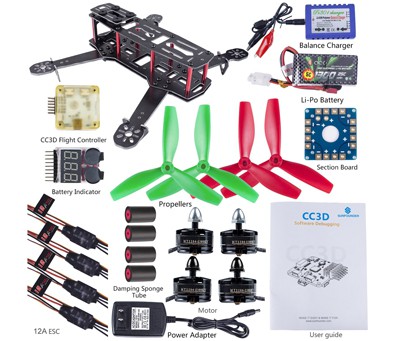
Jokes aside now – SunFounder 250 is based off of QAV250 (while, f.e., LHI model was ZRM250) and sports a full carbon fiber frame that’s lightweight and extremely durable. It runs on similar hardware just like the LHI with MT2204 2300kv motors and 12A ESCs. Powered by a 3S 1300mAh LiPo (I warmly suggest you purchase at least 1 more) there is no doubt this thing packs a punch.
When it comes to DIY part of the deal, you are going to be happy since SunFounder 250 provides with everything you need. This ranges from glue, zip ties, damping pipes, banana bullet connectors, Velcro tape etc… Almost everything you need to fully assemble this thing comes with the package. All you will have to do is get a FPV camera together with a vRx/Tx combo and you’re all set!
Show me the best price for : United States
FPV goggles for FPV Racing drones
One of the most important aspects of drone racing are definitely FPV goggles. Needless to say, they are of utmost importance since they provide with a unique point of view that allows you to take full grasp over your drone. With state of the art technology called head tracking, some of these models allow you to control your drone with head movement. Trust me, it’s insanely fun!
But, you have to keep in mind that not all FPV goggles work with all racing drones/racing drone kits. You have to make sure they work via same connection whether it’s wireless, Bluetooth (both integrated with cheaper models) or 5.8Ghz (high-end ones). Another thing you need to take note of is their respective bands. They must match otherwise you might end up purchasing FPV goggles that you cannot even use.
Below, you can find 3 awesome models that will definitely serve you right. They’re not overly expensive but are still capable of giving you that amazing feeling of FPV drone racing. So, without much further adue, let’s check them out!
Boscam GS922
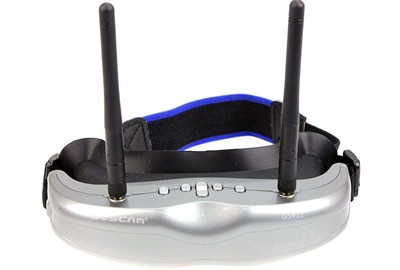
This pair of FPV goggles features an 854×480 screen (WVGA NTSC). It is insanely comfortable and not top-heavy at all, meaning you will not have any difficulties in wearing it for longer periods of time. You could end up sweating a bit since they’re dark and don’t provide fabric to breathe which attracts heat. Another very important aspect of Boscam GS922 is its price tag. Even though it has roughly the same characteristics as certain FatShark models, it’s sporting an aggressive price tag which is definitely a major plus.
Moving forward, I’d also like to mention that it features the newer 16:9 aspect ratio which will provide you with a wider image than what would be the case with 4:3. Unfortunately, onboard DVR doesn’t match the same traits. You see, it records videos in 640×480 which is 4:3. This will result in videos having black bars on all modern displays. But, despite that… I still consider Boscam GS922 to be awesome and well worth the money. So, if you need a new pair of FPV goggles for racing, these will not disappoint you!
Show me the best price for : United States
FatShark Dominator V3
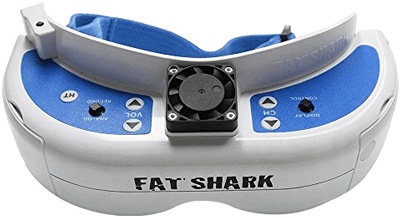
First of all, it is important to note that FatShark Dominator V3 does not come with a dedicated receiver module. In other words, you will have to supply your own and the best option currently available (one that’s officially supported) is made by NexwaveRF. Another decent option is La Forge Diversity Module (yes, receiver goes into module bay) which performs even better but has a particularly high price tag to its name.
With that out of our way, let’s talk more about performance. You’ll get a 16:9 WVGA (800×480) screen that has 30-degrees FOV. Needless to say, these are great specs for anyone wanting to enjoy drone racing. Moving forward, interpupilary distance is adjustable from 59 all the way to 69mm. FatShark Dominator V3 gives you optional diopter lens ranging from -2 through -4 and 6. People who wear glasses will really appreciate this.
In terms of features, FatShark Dominator V3 offers the already-mentioned modular bay which can be used for modules such as head tracking and virtually any band/channel receiver. Additionally, it also supports onboard DVR meaning you can record and do FPV stunts simultaneously. Bad new though, recordings are in 4:3 just like Boscam GS922.
Show me the best price for : United States
Avegant Glyph
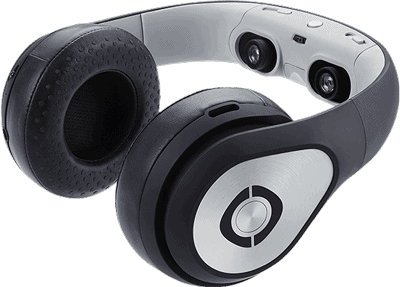
Instead of targeting the small drone racing niche (realistically speaking, even though it is rapidly growing, drone racing is still a tiny niche), they’ve targeted all tech-oriented people. You see, Avegant Glyph isn’t just FPV goggle solution for drones but a personal home theater as well. This thing can be connected to everything that has an HDMI port… including drones. It sports a single screenless display that’s made out of 2 million miniature mirrors which mimic what our eyes normally see. Technically speaking, we are talking about 720p resolution per eye. Avegant Glyph uses digital instead of analogue signals which is much better in terms of image quality but not so much when it comes to input lag and latency.
So… technically, these FPV goggles aren’t that drone-racing friendly but they still provide great value for money so I decided to give you a closer look. Don’t get me wrong – you can race with them. Input lag is not that terrible and won’t have a big impact on your performance unless you’re a professional drone pilot.
Show me the best price for : United States
Most important racing drone characteristics
- Speed and power
Undoubtedly, speed and raw power of a racing drone are of crucial importance for your overall performance on a tournament. Even though a huge dose of skill is required too, if you’re driving a slow drone equipped with mediocre motors, you are not going to have a good time winning any races. - Maneuverability
Other than being really fast, racing drones are also known for being extremely agile as well. They are able to do all sorts of spins, 360 flips and whatnot. There are even specialized tournaments in which the winner is decided by performing breathtaking tricks around the racetrack. - Durability
As I’ve already mentioned, drone racing is an extremely fast-paced sport and crashes are bound to happen. In order to keep your drone alive for the entire tournament you must either drive very carefully (which will result in you being last haha) or invest in durable parts. The latter is a much better option and you should not take it for granted! - Flight time
To be honest, flight time isn’t that big of an issue with racing drones. Most races are done under 10 or even 5 minutes which is not a breathtaking number. More importantly, you should definitely invest in quick charging batteries (or purchase extra ones) so you can replenish them in time for the next race. - Camera quality
Even though racing drones don’t require flashy 4K cameras, they still need proper FPV ones. You must make sure your camera has decent FOV as well as solid video transmission range in order to cover an entire racetrack.
Buying vs building a racing drone
The first question you will come across after deciding to take up drone racing as a hobby is definitely going to be – Should I buy a racing kit or a ready-to-fly drone instead? This depends on the amount of time you have at your disposal. Building your own drone requires a lot of time, especially if you’re not a DIY kind of guy. Even though there are all-in-one racing kits that require no additional parts, you will still have a lot of work at hand. Putting everything together, soldering the electronics and upgrading where possible – all that is much more time consuming than you might initially think.
I am not trying to scare you off buying a racing kit and building your own drone. That would be silly as I’ve built my fair share of drones back in the day and they all costed much less than if I went and bought an equivalent RTF model. It’s true! We are talking about 20-30% difference in prices. Plus, you will learn a lot on-the-fly which will make all additional repairs much easier. You’ll get the hang of all that DIY routine as well as a proper grasp on how your drone functions, allowing you to detect faulty parts if something goes wrong.
In the end, I guess you have quite a decision to make. But, whichever you choose, I’m sure you will have a ton of fun with drone racing! It’s an action-packed sport, unlike any other, making it incredibly fun and addictive.
Racing drone components explained :
Frame
Consider the frame sort of as a motherboard of your PC. It basically allows all other parts to be placed on top of it and keeps them safely together. Don’t be a cheapskate when it comes to frames as they’re the backbone of your entire build. Ideally, you should look for a carbon fiber frame of your desired size (250mm, 350mm etc) packaged together with damping balls that decrease flight vibration.
- Crazepony ZMR250 carbon fiber frame
- Readytosky 250 carbon fiber frame
Flight controller
As the name suggests, the sole purpose of flight controllers is to… well… control your flight. All flight aspects such as flying sensitivity, stability, maneuverability heavily depend on the type of flight controller you go for. Think of it as the nervous system of your drone. It effectively keeps tabs on everything that’s going on while your drone is flying. With that said, you should do a lot of research before purchasing one. These 2 down below are a good start!
- RJXHOBBY SP Racing F3
- Crazepony F3 EVO with PD board
ESC
Short for Electronic Speed Control. These tiny parts are in charge of controlling the performance of your motors. As a matter of fact, if you want your drone to be agile and speedy in terms of quick maneuvers, then ESC is something you should not take for granted. When it comes to picking out ESCs, make sure you take note of amperage as wrong setup could cause plenty of issues to your build. One last thing – you need a total of 4 ESC for your build (1 next to each of your motors) but having 1 or 2 extra sets might come in handy more often than not.
- MakerFire 2-4S ESC 20A
- Hobby-Ace XS30A 3-6S
Motors
Motors represent the sheer firepower of your drone. They make all the magic, especially in the speed department and as such they should not be taken lightly. If you want to win races, you shouldn’t be a cheapskate when picking out motors. First thing – you need brushless ones. Not only are they more reliable than standard brushed ones, they are also well-manufactured and will last much longer. I will not get into any further details as the type of motors heavily depends on other parts of your build such as ESC and battery.
- DLFOV DX2205 2300KV Brushless Motors
- EMAX RS2306 2750kv 3-4S brushless Motors
RC transmitter/receiver
Back in the days, people had to use FM and even older AM receivers/transmitters. Fortunately, that technology is now obsolete as we have 2.4 and 5.8Ghz connections available. The latter is most often used for vTX (FPV transmitters) while 2.4Ghz is used for radio control. First thing you need to know is whether you’re going to use PPM or PWM controls. Second, the desired frequency must also be matched. From there, I’m sure you’ll able to find an appropriate model that will work with the rest of your build.
- Radiolink AT9S 2.4Ghz 9CH transmitter and R9DS receiver combo
- Radiolink AT10II 2.4Ghz 10CH transmitter and R10DII receiver combo
Propellers
A single drone racing tournament has more than a few crashes. The first thing that breaks is always the props. Whether you’re using prop guards or not, they’re still prone to breaking even in lightest of crashes. That’s why you should always have at least 2 or 3 extra sets available if something goes wrong. Of course, you can always go for premium ones that are made from highest quality materials and won’t break that easily. Keep in mind that, for racing, you should go for tri-blade props as they provide the most lifting power.
- Arris Bullnose 210-250
- Dalprop T5045C Cyclone
- LiPo batteries
Battery
Your drone has to run on something, right? Well, over 90% of modern day drones run on high power lithium Ion batteries. Their main advantage over NiMH batteries is higher capacity (for example 1300mAh), lighter weight and better discharge rates (for example 30C). In addition to capacity and discharge rate, you should also pay attention to battery voltage (for example 7.4V) and cell count (for example 3S) as that will greatly affect your drone’s overall performance. Another noteworthy aspect is charging speed. The faster it is, the more frequent your flights will be.
- Crazepony Infinity Graphene LiPo Battery 1500mAh 90C 4S 14.8V
- Tattu 1800mAh 75C 4S1P LiPo 14.8V
HD action cam
Drone racing cameras are much different than standard aerial photography ones. First of all, for drone racing you want a high-quality CCD camera and not a CMOS one, since they use a global shutter that captures entire image at once. Moreover, you should also use TVL (TV lines) cameras instead of common HD ones. That’s because common HD cameras generally have 100-300ms of input lag which means a lot at high speed maneuvers. On the other hand, TVL CCD cameras have minimal lag and perform better in terms of dynamic range, allowing you to see better in very bright or dark conditions.
- RunCam OWLPLUS 700TVL
- Crazepony Foxeer HS1177 600TVL
Drone racing tournaments
Believe it or not, drone racing is developing rapidly. After last year’s world championship in Hawaii, drone racing is setting the stage for more than a few high-speed spectacles this year. In addition to the biggest, international tournaments that are going to be accompanied by the best professional drone pilots out there, there are also many local competitions all around the world… but mostly in the USA. A simple Google search will tell you all you need to know about the scheduled drone races in your area. There is really a ton of them happening virtually every weekend so it is definitely worth checking out… that is, if you have a decent racing drone at your disposal.
**Drone Racing League**
DRL AKA Drone Racing League is an action packed professional done racing league which features races all over the world. The best players compete at thrilling locations worldwide and battle each other for points by finishing faster and more accurate. DRL pilots are using custom made drones tailored to perfection. With state of the art parts and a whopping 209 RGB LED lights, these powerful machines are insanely fast and agile. After all, they need to be in order to make their way through demanding racetracks. One thing is for sure though – it takes a lot of talent and practice to join these professional pilots and race with these monstrous machines!
Different categories of racing drones
A lot of people believe that different drone categories represent the actual length of a drone, but needless to say, that’s not the case. Drone racing categories at various tournaments are measured in millimeters and actually represents the distance between the 2 furthest motors on a drone (usually the distance between 2 diagonal motors). The most usual sizes are 125, 250 and 350mm but there are plenty more to be seen out there.
With that being said, if you are keen on registering for a tournament that has just one single drone category, this is what you have to keep in mind – 250mm drone racing tournament will only accept 250mm drones. Logically, 350mm and all other types are strictly prohibited… I know for a fact that some people believe that they can apply to a 350mm tournament with a 250mm racing drone because it’s under the 350mm limit. There’s no such limit. The only rule you have to follow is to come with a 250mm drone. True, 10% oscillation is OK and will pass just fine on most tournaments… but anything above/under those 10% and you’re going to get yourself disqualified.
Conclusion
Ladies and gentlemen, boys and girls, I am afraid you’ve come to the end of this article! As you can tell, there’s been a plethora of information featured. Come to think of it, I am positive that this is one of most extensive drone racing guides you can find online. Needless to say, I put a lot of effort in this and sincerely hope that I managed to help you. Even though drone racing might seem like an easy hobby, in reality things are much different. There are tons of things that can go wrong, tons of little parts that can become faulty over time… and a ton of maintenance to do. So, if you’re still interested in drone racing and you think you have what it takes to reach the top (and ready to get your hands dirty from time to time) don’t hesitate to pick one of those racing drones/kits I listed above.
With that said, I’d like to thank you for reading this and wish you best of luck on racetracks all around the globe!
The post Racing drones : The ultimate guide appeared first on DronesGlobe.com.


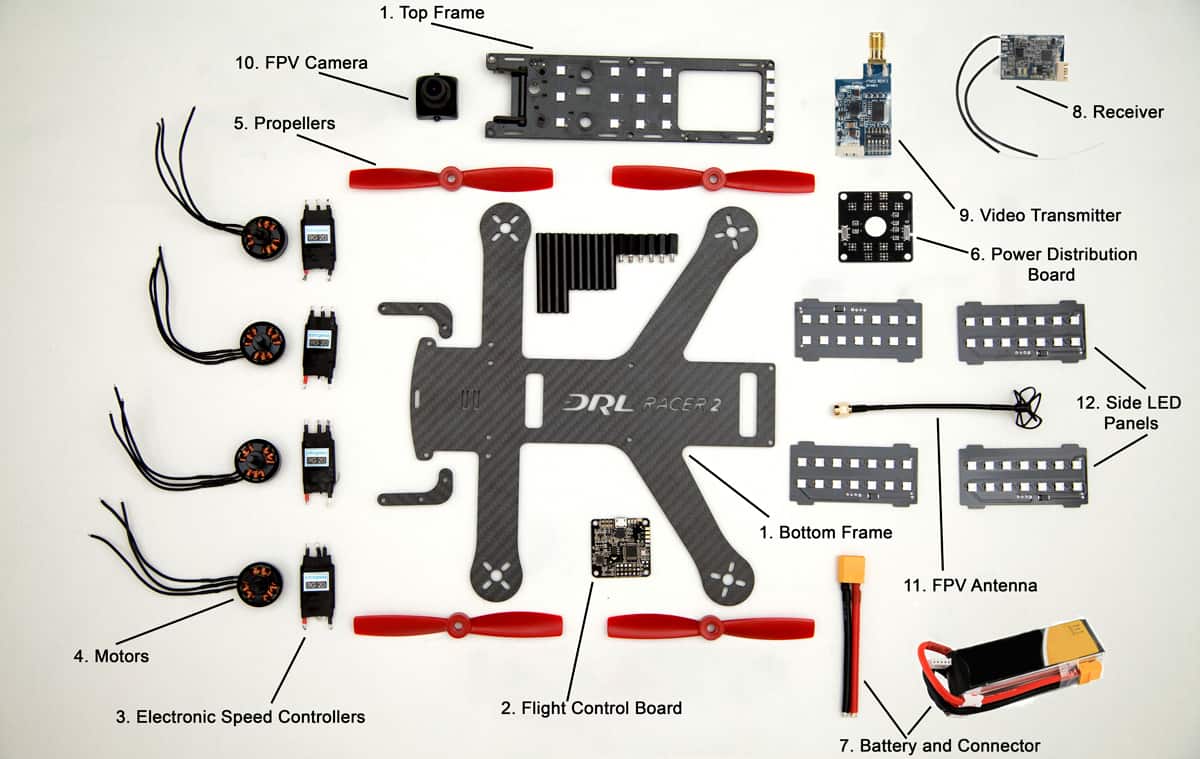

Great article is very helpful for knowing uses of camera drone. Camera drone is most useful for a detective, they capture important picture, news of killer and take information for their investigation. So, mini-drone is most needy for us.
ReplyDelete